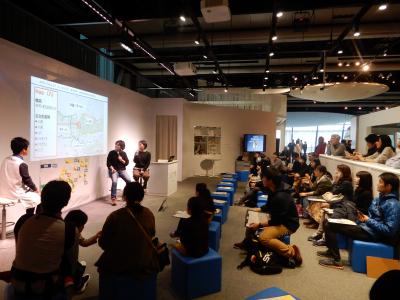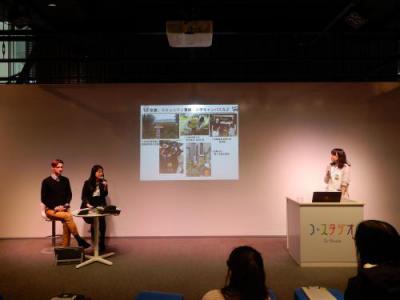Seeking a sustainable future in scenes from daily life

Many people may think of “environmental problems” as matters to be addressed by science. But in fact, we can think about what a sustainable environment and society should be just by looking at what we see right around us and at what we see in our memories. In the spring of 2019, we planned an event around this idea of thinking about environmental problems through familiar landscapes and episodes.
We organized an event titled “Let’s Have a Look! Clay, Honeybees, World Food: Toward Sustainable Societies,” at Miraikan (National Museum of Emerging Science and Innovation) in Tokyo’s Odaiba, on March 16, 2019. The event featured talks with research experts from the Research Institute for Humanity and Nature (RIHN) in Kyoto and the showing of specially prepared videos. The three sessions on the topics of ceramics, beekeeping, and food in Bhutan, began with a short, 15-minute video, after which RIHN researchers presented further background and explanation, referring to what was seen in the videos.
The videos were made to record the daily lives of ordinary people at a certain point in 2018. For example, the video that I recorded and edited was entitled “Quietly a Great Wave” covers a day in the life of a household in a rural village in the western part of the kingdom of Bhutan. It shows the young couple of the family waking early on a winter morning. They warm themselves with milk tea while their parents and their children are still sleeping and then head out to the barn, their boots packing down a path in the snow, to get the milk they need to make milk tea, butter tea, and cheese for the family. First, they let the young calf nurse, and when it has had a certain amount, they draw the calf away and start to milk the cow for themselves. The grandmother of the family uses the milk the calf has shared to make butter and cheese, essential ingredients of all sorts of dishes for the household.
Up to that point, the video seems to be showing a happy scene of self-sufficient local life. But in recent years, rapid urbanization and an increase in imports from India are bringing about great changes in Bhutan. We can see the impact of these changes even in the kitchen of this family. When making kewa datshi, a leading traditional Bhutanese dish made from potato and cheese, I noticed that along with the homemade cheese, they also added sliced cheese, which seemed have been imported from India. Their comment that “It doesn’t taste good unless we add this,” tells a lot about how changes in Bhutanese food and agricultural systems have affected changing tastes.
As reliance on imported foods increases, major changes take place in domestic food and agricultural systems. The aggravated burden on the environment of mass production of goods in factories and the contingent waste that is produced are issues that cannot be overlooked. How should we deal with this kind of phenomenon, which is found not just in Bhutan but in many other parts of the world? Dr. Mai Kobayashi , RIHN specialist on food and agricultural systems of Bhutan and co-director of the “Quietly a Great Wave” video, commented as follows about sustainable food and agricultural systems:
We have to learn where the food we eat comes from and think about the impact that our choices and consumption of food have on the environment. And we have to be responsible for our choices.
Prompted by comments like these, together with questions and comments from the audience, who were mostly people living in Japan, we reflected on the situation we are in today.
Environmental problems are not something happening far away; they are closely involved with our own lives. The videos shown at this event brought into vivid focus the ways environmental issues are embedded in our daily lives. The participating researchers used videos to introduce the content of their research, helping us to place what might seem like trivial episodes in larger contexts and think more deeply about environmental issues. Perhaps it is part of the role that the humanities as a whole will be called upon to play from now on. And RIHN being one of the institutes of the National Institutes for the Humanities – a driving force of research in the humanities in Japan-, it is perhaps RIHN’s mission to create opportunities to rethink environmental issues as cultural issues.

Scenes from the event

Scenes from the event
Related information
“Let’s Have a Look! Clay, Honeybees, and World Food: Toward Sustainable Societies”
Date: Saturday, March 16, 2019
Times: Session 1 (12:00-1:00 p.m.); Session 2 (1:30-2:30 p.m.); Session 3 (3:00-4:00 p.m.)
Place: Miraikan, Co-Studio, 5th floor
Host institutions: Miraikan, Research Institute for Humanity and Nature
Kim Satbyul, Project Assistant Professor, Research Institute for Humanity and Nature
Born in Korea, Kim completed her doctoral degree at SOKENDAI in 2016. Specializing in cultural anthropology, her focus of research is death and burial rituals and visual anthropology. She took up her present position in 2017.
